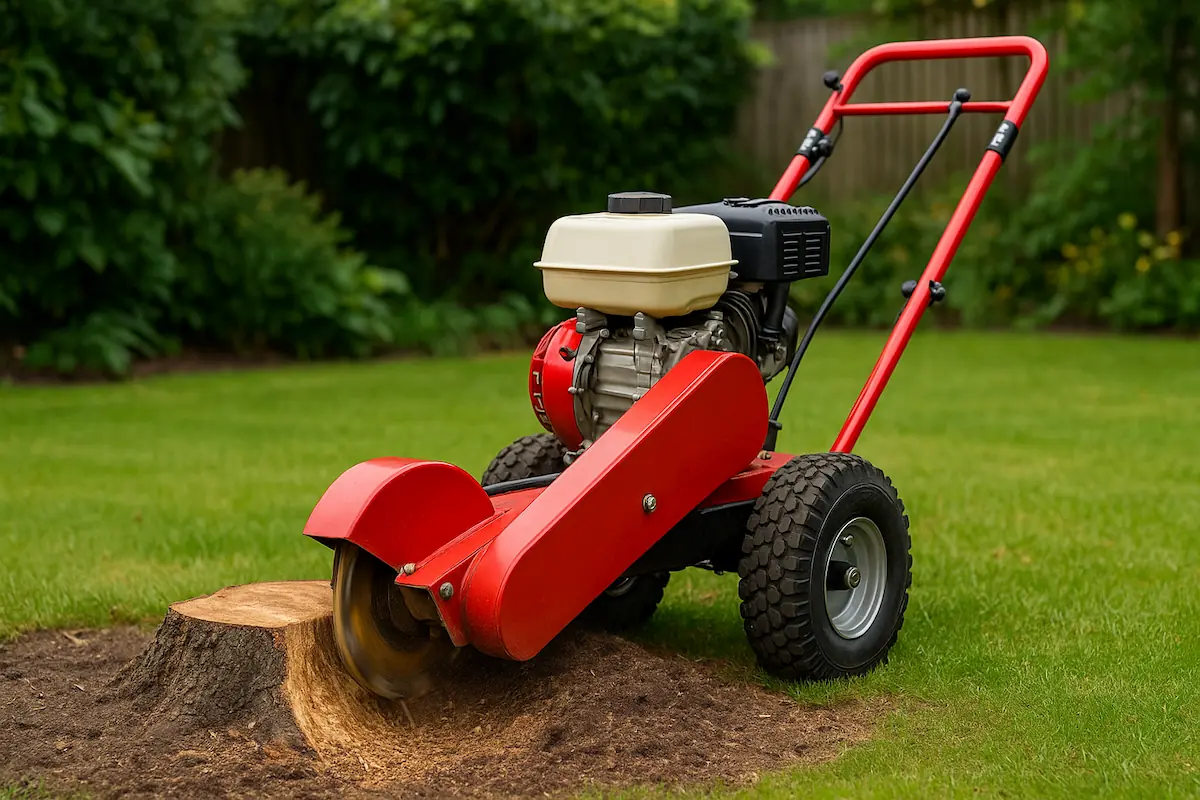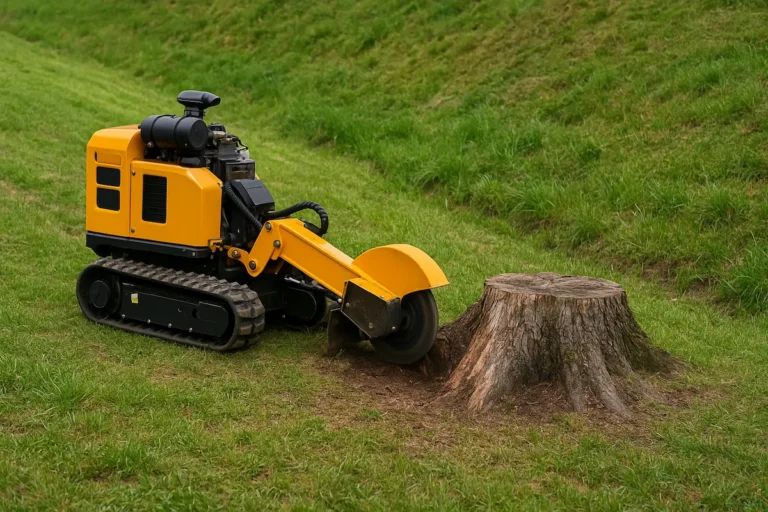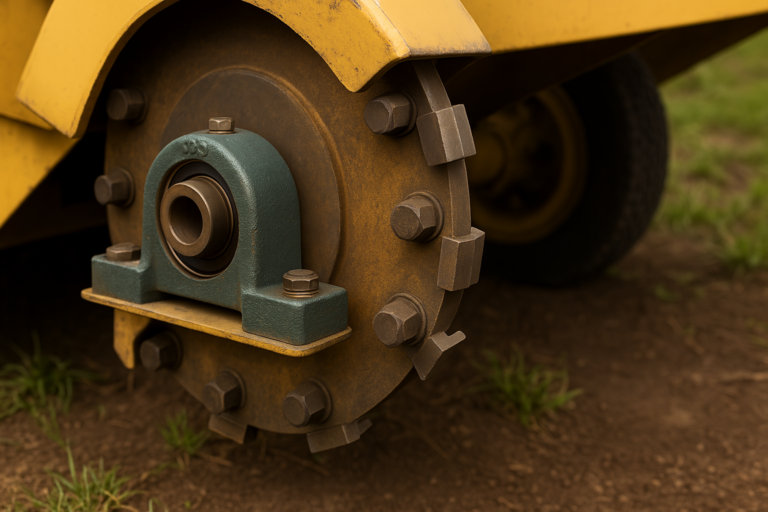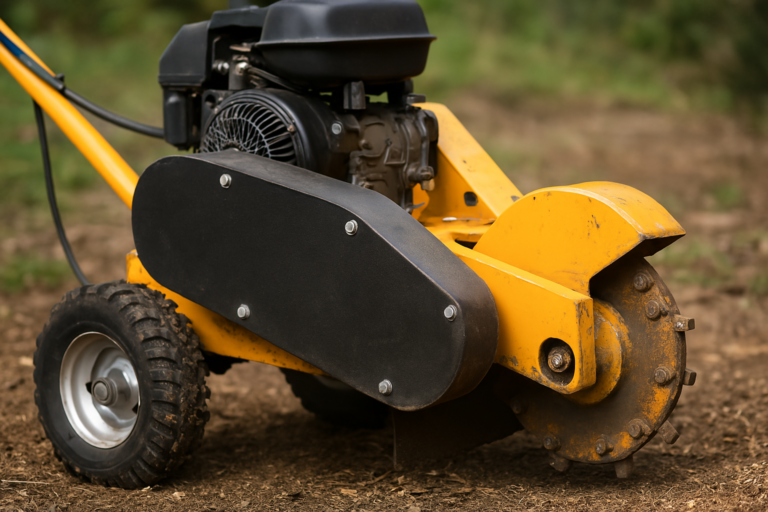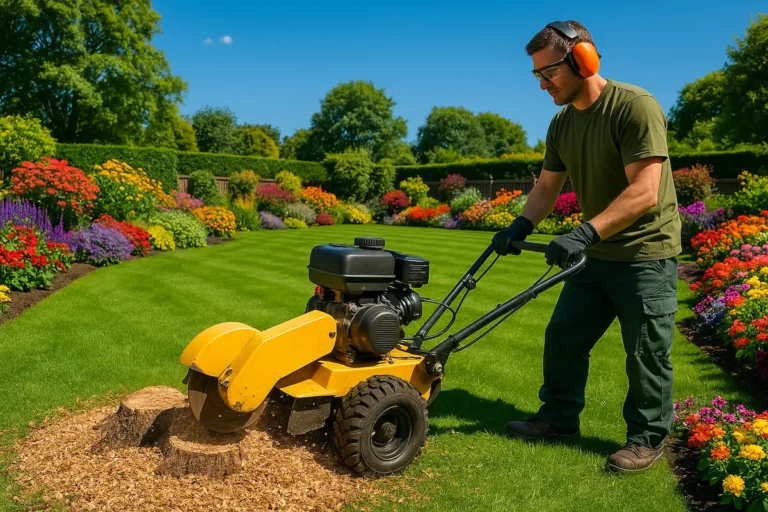Understanding ‘Push-Pull Handle’ Stump Grinders: A UK Hire Guide
Are you thinking about hiring a stump grinder now?
You might hear the term ‘Push-Pull Handle’.
This means you push and pull a grinder by hand using its handlebars.
These are standard walk-behind stump grinders available for hire.
This guide explains exactly what they are and how to use them safely.
Stump Grinder Comparison: Manual vs. Hydraulic
Key Takeaways from the Chart
- Effort: Manual ‘Push-Pull’ grinders require significantly more physical effort from the operator compared to the low effort needed for Hydraulic models controlled by levers.
- Speed & Precision: Hydraulic grinders are generally faster and offer higher precision due to powered controls, whereas Manual grinders are slower and less precise.
- Cost & Size: Manual grinders typically have a lower hire cost and are smaller/lighter, making them suitable for budget projects and tight access. Hydraulic machines cost more to hire and are larger/heavier.
- Suitability: Choose a Manual ‘Push-Pull’ grinder for small-medium stumps, tight budgets, narrow access, and if physically capable. Opt for a Hydraulic grinder for large/multiple stumps, faster completion, less physical strain, or professional use.
What Does ‘Push-Pull Handle’ Mean for Stump Grinders?
Defining the Term: It Refers to Manual Handlebar Control
The name ‘Push-Pull Handle’ isn’t officially spoken in the industry.
But people use it because it perfectly describes how you move the machine.
Use the handlebars to push and pull the cutting wheel across the stump.
This method is used on many smaller stump grinders you walk behind.
It’s different from bigger machines that use levers to control hydraulic arms.
Identifying Grinders Using This Manual System
How can you spot one?
Look for a stump grinder where the operator stands behind it.
They hold onto handlebars, much like a lawnmower.
They use their strength to swing the machine side to side.
No complex joysticks or levers control the swing motion.
These are often the most common types in UK hire shops for DIY jobs.
How We Operate a Manual ‘Push-Pull’ Stump Grinder
The Core Mechanism: Leverage and Pivot Point
These grinders work using simple leverage.
Imagine the wheels (or a point near them) as a pivot.
The long handlebars act like levers.
You push or pull the handlebars.
This makes the cutting part of the machine swing in an arc over the stump.
It’s like rocking a seesaw, but side-to-side.
Many models have a brake for one wheel.
You lock this brake.
This creates a fixed pivot point.
It makes the swinging motion easier to control.
Key Controls You Need to Know
Using these grinders is relatively straightforward.
Here are the main parts you’ll use:
- Handlebars: You hold these to steer and swing the machine.
- Throttle Lever: Controls the engine speed, like a car’s accelerator.
- Cutter Engagement Lever/Clutch: Starts and stops the cutting wheel spinning. Safety is vital here.
- Wheel Brake Lever (on some models): Locks one wheel to help you pivot the machine smoothly.
- Engine Start: Usually a pull cord, sometimes an electric start button.
- Safety Bar/Switch (Operator Presence Control): Often, you must hold a bar against the handlebar for the cutter wheel to stay engaged. Let go, and it stops. This is a key safety feature.
Before you start, always ask the hire shop staff to show you the specific controls for the model you hire.
User Quote:
“Took me a minute to figure out the wheel brake, but once I did, swinging the grinder was much less effort.” – DIY user comment summary from online forums.
Step-by-Step: Using a Manual Handlebar Stump Grinder Effectively
Operating a manual stump grinder needs care and the proper technique.
Follow these steps for a safe and effective job.
Prioritise Your Safety: Essential Checks and PPE
Safety first, always!
Wear the proper Personal Protective Equipment (PPE).
- Eye Protection: Safety glasses or a full-face visor are essential. Wood chips fly fast!
- Hearing Protection: Ear defenders or plugs. These machines are noisy.
- Gloves: Sturdy work gloves help grip and protect from blisters and debris.
- Footwear: Strong boots, preferably steel-toe capped. No trainers or sandals!
- Trousers: Wear tough work trousers, not shorts.
Check the Work Area.
Clear away rocks, stones, garden tools, toys, and other debris.
These items can be thrown by the grinder or damage the machine.
Mark any underground pipes or cables if you know their location.
Keep pets and other people well away from the area while you work. A distance of at least 15 metres (50 feet) is often recommended.
Check the Machine.
Make sure it has enough fuel and oil.
Check that the controls work smoothly before starting the engine.
Ensure the cutting teeth look sharp and are not damaged or loose. Report any issues to the hiring company immediately.
Positioning the Grinder Correctly at the Stump
Roll the grinder close to the stump.
Position the cutting wheel just above the edge of the stump you want to start on.
Start high on the stump; don’t try to plunge straight down.
Ensure you have stable footing.
Starting the Engine and Engaging the Cutting Wheel
Follow the hire company’s or manufacturer’s instructions.
Typically, this involves:
- Turning the fuel tap on.
- Setting the choke (if the engine is cold).
- Turning the engine switch on.
- Pulling the starter cord firmly (or using the electric start).
- Letting the engine warm up for a minute.
- Adjusting the choke as the engine warms.
- Increasing the throttle to the correct operating Speed.
- Carefully engage the cutter wheel using the lever or clutch. Listen for the change in sound as it spins up. Keep hands and feet clear!
Master the Push-Pull Sweeping Technique
This is the key part of ‘Push-Pull’ grinders.
Plant your feet firmly and slightly apart.
Keep a good grip on the handlebars.
Engage the wheel brake (if fitted) on the side you want to pivot around.
Slowly and smoothly push or pull the handlebars.
This will swing the spinning cutting wheel across the face of the stump.
Use your body weight, not just your arms, to help move the machine.
Necessary: Make shallow passes.
With each sweep, grind off about 1/2 inch to 1 inch (1-3 cm) of wood.
Trying to cut too deep will strain the engine, which might stall and make the grinder harder to control.
It can also make the machine jump unexpectedly.
Listen to the engine sound. If it bogs down, you are cutting too deep or too fast.
Sweep across the entire top layer of the stump first.
Technique Tip:
“Think of it like sweeping with a tough broom. Slow, steady, shallow sweeps work best. Don’t rush it!” – Advice from an experienced hire operator.
Advancing Across and Grinding Deeper
You must move in or down once you have swept across the top layer.
Release the wheel brake (if engaged).
Move the grinder slightly forward (a few inches).
Some models also have a way to adjust the cutting head depth slightly.
Re-engage the wheel brake if using it.
Start your sweeping passes again across this new section.
Repeat this process: sweep, advance, sweep, advance.
Continue until the stump is ground down to the desired depth below the surface. Usually, 4-6 inches (10-15 cm) is enough to prevent regrowth and allow for new turf or planting.
Maintain a steady rhythm and focus.
Manual Push-Pull vs Hydraulic Controls: Which Grinder Should You Hire?
Not all stump grinders work the same way.
Many larger grinders use hydraulic controls.
This means levers or joysticks control the machine’s movements using hydraulic power.
Let’s compare the manual ‘Push-Pull’ system with hydraulic controls.
Comparing Control Systems: Effort, Speed, and Precision
We can break down the differences:
| Feature | Manual ‘Push-Pull’ Handle Grinder | Hydraulic Control Grinder |
|---|---|---|
| Effort Level | High – Requires significant physical strength and stamina. | Low – Operator uses levers/joysticks, minimal physical effort for movement. |
| Cutting Speed | Slower – Especially on large or hardwood stumps. Cutting depth is limited by operator strength and engine power (typically 9-25 HP). | Faster – More powerful engines (25+ HP) and hydraulic power allow deeper, quicker cuts. |
| Precision | Lower – Harder to make very fine, controlled movements. | Higher – Levers allow for precise positioning and smoother sweeps. |
| Typical Hire Cost (UK) | Lower – Generally cheaper per day/week. | Higher – More expensive due to complexity and power. |
| Machine Size | Smaller/Lighter – Typically 70kg – 180kg. Better for tight access. | Larger/Heavier – Often 200kg – 1000kg+. May need ramps or trailers. |
| Best For | Small to medium stumps (up to ~12-18 inches diameter), occasional use, tight garden access, budget projects, users physically able to handle the work. | Large stumps, multiple stumps, professional use, faster job completion, users preferring less physical work. |
| Ease of Use | Simple mechanics, but physically demanding technique. | More controls to learn, but easier physically once understood. |
Statistic Snippet: Walk-behind manual grinders often weigh between 70kg and 180kg. While lighter than hydraulic units, this weight still requires considerable effort to manoeuvre during grinding.
Advantages of Hiring a Manual ‘Push-Pull’ Grinder
Why might you choose this type?
- Lower Hire Cost: They are usually the cheapest stump grinders to hire per day. This saves money on smaller jobs.
- More straightforward Mechanics: Less complex parts mean potentially fewer breakdowns (no hydraulic hoses/pumps to fail). However, engine or belt issues can still occur.
- Great for Tight Access: Their smaller size means they can often fit through narrow garden gates (check width first!). Larger hydraulic machines might not fit.
- Good Enough for DIY: Perfect for tackling one or two small-to-medium-sized stumps in your garden.
User Feedback:
“Hired one for a weekend. Got through three small stumps in the back garden where a bigger machine wouldn’t fit. Saved me calling in the pros.” is a common sentiment from DIY hirers.
Disadvantages and Key Considerations
What are the downsides?
- It’s Hard Work! This is the most significant point. You need to be reasonably fit and prepared for a physical workout. Swinging the machine back and forth takes effort, especially for extended periods.
- “It’s a real workout! Takes a lot of muscle to swing it back and forth.” – Frequently heard feedback.
- Slower Progress: Grinding takes longer, especially on dense hardwood (like oak) or larger stumps. Be patient.
- Less Precise Control: Achieving a perfectly smooth, level finish with precise hydraulic movements is harder.
- Operator Fatigue: Getting tired increases the risk of making mistakes or having an accident—plan for breaks.
- “Can be tiring and lead to operator fatigue quickly.”
- Tricky on Slopes: Using these on uneven ground or slopes is much harder and potentially less stable. Hydraulic machines often handle slopes better.
- “Not fun on slopes or uneven ground.”
If you have many large stumps, are not physically up to heavy work, or need the job done quickly, hiring a hydraulic grinder might be a better choice, even if it costs more.
Common UK Hire Models with Manual ‘Push-Pull’ Handles
You’ll find several reliable models with manual handlebar controls in UK hire shops.
Here are some examples you might see:
- Dosko 337-S / 337-H: These are very popular hire machines. They are known for being tough and relatively simple. Videos often show their distinct manual push/pull sweep action. They typically have around 13 HP engines.
- Bluebird SG13 / SG1314B: Another common sight in rental stores. It is often used in DIY tutorial videos demonstrating manual operation. Similar power range to the Dosko.
- Rayco RG13 / RG25: Rayco makes grinders of all sizes. Their smaller walk-behind models often use handlebar leverage for control.
- Vermeer SC252 / SC30TX (Basic Operation): While some Vermeer models have hydraulic options, their smaller walk-behind units often rely on manual handlebar positioning and sweeping.
- Barreto SG Series (Smaller Models): Barreto offers robust grinders, and some of their smaller walk-behind units use manual handlebar control.
Typical Specs:
- Weight: Around 70 kg to 180 kg (150 to 400 lbs). Check you can handle moving this weight, especially loading/unloading if collecting yourself.
- Engine Power: Usually 9 HP to 25 HP. More horsepower generally means slightly faster grinding, but the manual effort remains.
- Cutting Depth: Depending on the model, You can grind 4-12 inches (10-30 cm) below ground.
- Width: This is important for access. Many are designed to fit through standard garden gates (around 26-30 inches / 66-76 cm wide). Always check the specific model’s width!
Quick Scan: Common Problems & How to Avoid Them
- Problem: Engine Stalls Frequently.
- Cause: Trying to cut too deep or too fast. Dull cutting teeth.
- Solution: Take shallower passes. Listen to the engine. Check teeth condition before hiring.
- Problem: Grinder Jumps or Kicks.
- Cause: Hitting a hidden rock or root. Cutting too aggressively.
- Solution: Clear the area well. Use smooth, controlled sweeps. Don’t force the machine.
- Problem: Excessive Vibration or Wobble.
- Cause: Damaged or unbalanced cutting teeth. Loose bolts.
- Solution: Stop immediately. Do not use. Could you report it to the hiring company?
- Problem: Operator Gets Tired Very Quickly.
- Cause: Underestimating the physical effort. Poor technique.
- Solution: Use your body weight, not just arms. Take frequent breaks. Consider a hydraulic model for big jobs.
Crucial Safety Advice for Operating Manual Grinders
Safety is even more critical with physically demanding machines.
Manage Fatigue: Take Regular Breaks
This type of grinder requires effort.
Being tired makes you less careful.
Plan to take short breaks every 20-30 minutes, mainly if you’re not used to physical work.
Drink plenty of water.
Stop if you feel overly tired or unwell.
Maintain Control: Avoid Over-Reaching or Forcing Cuts
Always keep a firm grip and stay balanced.
Don’t try to reach too far with the grinder. Reposition your feet or the machine instead.
Never force the cutting wheel into the wood.
Let the machine do the work at its own pace.
Forcing it can lead to stalling, kickback, or losing control.
Remember: Shallow, steady sweeps.
Be Aware of Your Surroundings and Machine Movement
Constantly check that the safety zone around you is clear.
Be mindful of where the wood chips are flying.
Understand how the machine pivots and moves. Ensure you have enough space.
Never put hands or feet near the cutting wheel when it’s spinning, or the engine is running.
Always switch off the engine completely before making adjustments, clearing debris, or refuelling.
Safety Statistic: Flying debris is a significant hazard. Wearing certified eye protection (like BS EN 166 standard) is non-negotiable when operating a stump grinder.
Is a Manual ‘Push-Pull’ Stump Grinder Suitable for Your Job?
Should you hire a manual ‘Push-Pull’ handle grinder?
Consider this type if:
- You only have one or a few small-to-medium-sized stumps (e.g., up to 18 inches / 45 cm diameter).
- Your budget is tight, and you want the lowest hire cost.
- You must get the grinder through a narrow gate or into a tight space.
- You are physically fit and prepared for manual labour.
- You are not in a huge rush to finish the job.
Think about hiring a hydraulic grinder instead if:
- You have many huge stumps (over 18 inches / 45 cm).
- The stumps are hardwood (like oak beech).
- You have physical limitations or prefer not to do heavy manual work.
- You need the job done as quickly as possible.
- The ground is very uneven or sloped.
- Access width is not a problem.
Real User Scenario:
“I had one large oak stump and five smaller pine stumps. I tried the push-pull grinder first because it was cheaper. I managed the small ones okay, but the oak took forever and nearly killed me! I swapped it for a hydraulic model the next day – it cost more, but I finished the oak in under an hour. Lesson learned!”” – Summary from a landscaping forum post.
Find and Hire Your Manual Stump Grinder Today
Ready to tackle those stumps?
Manual ‘Push-Pull’ handle grinders are a great budget-friendly option for many DIY jobs.
Explore Our Range of Walk-Behind Stump Grinders
We list various walk-behind stump grinders available for hire across the UK, including many manual control models.
Find the right machine for your needs easily.
Get a Personalised Hire Quote Online
Which grinder is best?
Need specific pricing and availability in your area?
Contact us or use our online form for a quick quote.
Conclusion: Choosing the Right Stump Grinder Hire
‘Push-Pull Handle’ stump grinders are simply manual walk-behind models.
They are cheaper to hire and plentiful for tight spots.
But they require real physical effort from you.
Think carefully about your job size and your fitness level.
Compare manual vs. hydraulic options using our guide.
Choose the grinder that best fits your needs and abilities for a safe, successful job.

